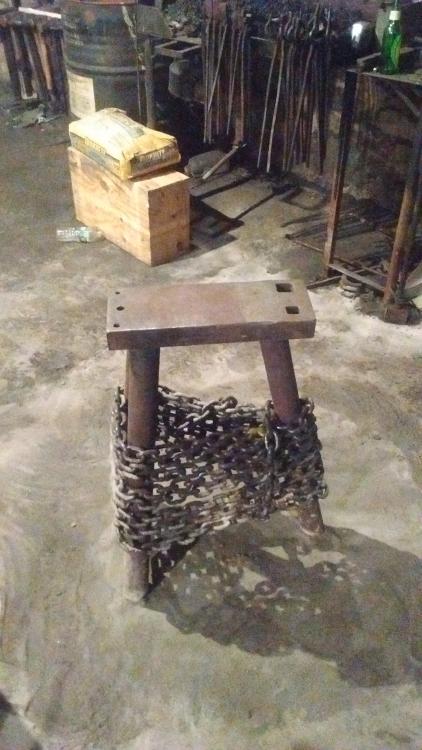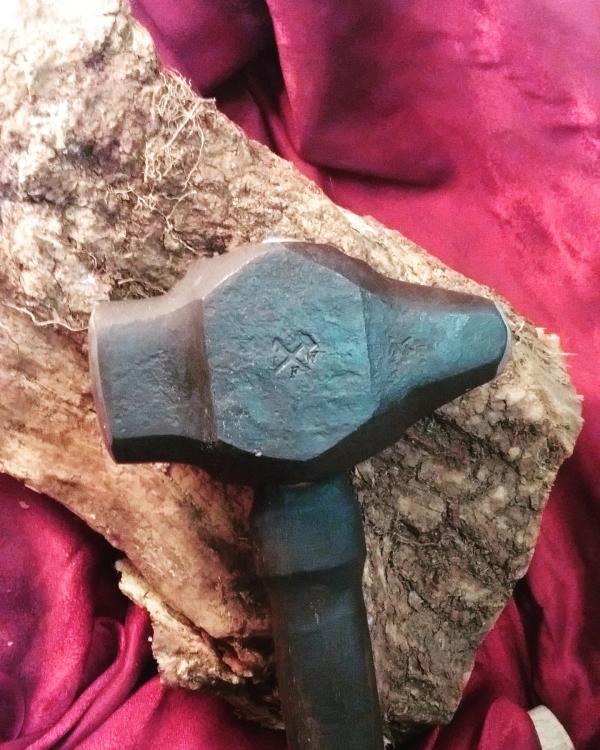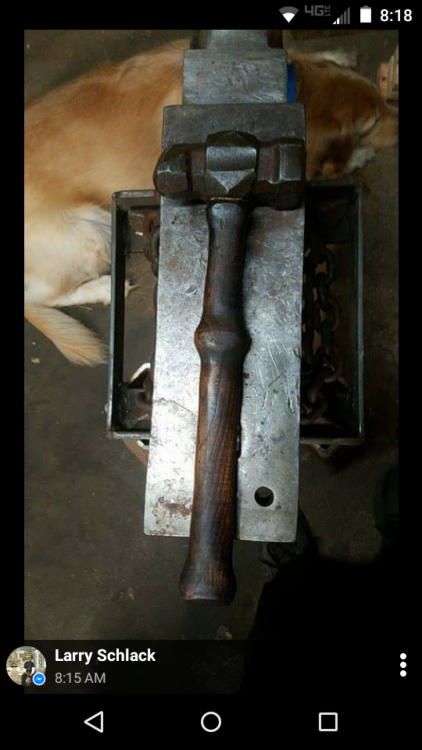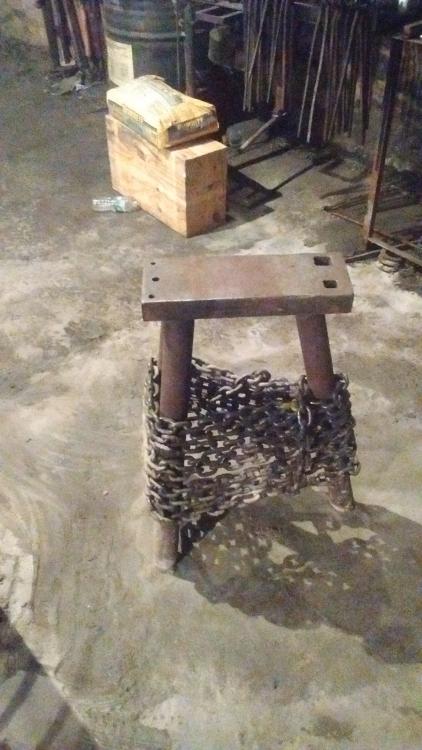-
Posts
830 -
Joined
-
Last visited
Content Type
Profiles
Forums
Articles
Gallery
Downloads
Events
Everything posted by Crazy Ivan
-
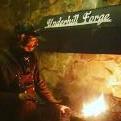
The quest to identify mystery steel
Crazy Ivan replied to Michael Cochran's topic in Blacksmithing, General Discussion
Remember that hardening is not limited to heat, quench, temper. Especially with exotic alloys, things such as stress relieving, cryo cycling, molten salts, marquenching, austempering and even pack quenching are needed. Likely more time consuming than is worth the effort (never mind the equipment ) to figure out on your own. It's not really gonna be easy to figure out what you need to do for a desirable HT here. -
This is really awesome frosty! I'm looking forward to hear more!
-
I didn't put anything in the legs of mine. It's quiet without the chain still because it's a part of the floor, but I just like how the chain looks lol. A striking anvil should be secured to the shop floor since they are top heavy by design and will walk around under a heavy hammer. That takes alot of the vibration out of the legs which is what produces the ringing sounds.
-
Just weld the legs to it. My striking anvil is made from S7 and the legs are plain ol mild steel. Not a weld for a beginner to attempt with the alloys I used,but you never specified what your striking anvil alloy is.
-
Good hammer geometry can make it feel like that. That's why I make my own.
- 18 replies
-
- hammers
- blacksmith
-
(and 5 more)
Tagged with:
-
I use my 6 lber and my 3.5 lber the most. That and my 10 and 14. All of them are used daily. I can only find a pic of my 6 lber right now though. Made by me.
- 18 replies
-
- hammers
- blacksmith
-
(and 5 more)
Tagged with:
-
Sad news here. He definitely became a friend in the short time we knew each other. A vast wealth of knowledge and definitely a kind soul. He will be missed. I rang my anvil for him this morning next to a fresh fire. RIP brother.
-
Also curious for the same reasons.
-

Vibration damage to arm over time
Crazy Ivan replied to blackleafforge's topic in Safety discussions
that handle gives you 4 different grip points. The bulge on the end locks your hand at the end of the handle (with a loose grip), the bulge in the center is either a forward hand gauge (to feel where your hand is mid swing when changing hold) and also as an intermediate forging point where I put my pointer finger over it (which also encourages and benefits a loose but secure grip), and lastly above the bulge is an excellent placement for planishing blows and the bulge acts as I've already mentioned. Make sense? -

Vibration damage to arm over time
Crazy Ivan replied to blackleafforge's topic in Safety discussions
Aside from what has been said, loose grip is a must. Add good hammer form (wrist, shoulder, elbow working together with your elbow tucked in to your side) and you should be okay. I designed my handles to encourage a loose grip while still maintaining a solid hold on your hammer. Pictures: -
I didn't actually help so much as shouting advise to you occasionally. You made this on you're own. Turned out great! Good work. The next 100 will be even easier
-
That will do you just fine. If you ever feel the need for a larger striking anvil, machine shops are your friend. My striking anvil is made from a 2"x6"x16" long drop of S7. Mild steel will do just fine for a striking anvil however. I just like to use the best alloys available to me. Mine also has a 500+lb slab poured around it to add to stability. The threaded anchors couldn't take my previous abuse. I put a 1" and a 1 1/2" hardy hole on one end and 3/8",1/2", and 5/8" pritchel holes on the other end. Let's see that hammer when you're done!
-

Have come upon some bigger 4140 what to do
Crazy Ivan replied to matto's topic in Blacksmithing, General Discussion
If you're feeling like shipping any, I'll buy some 3" or 3.5" from ya That 5 3/4" would make a mighty fine block anvil. Power hammer dies are always an option. That's all I've got off the top of my head though. -
I'm planning on being there. I've been too busy to get anything together to table with but I plan on raiding all the tailgates until the truck is filled to capacity. Look for the 6'-2" "biker looking person" with face tattoos. I shouldn't be too hard to spot. I'm nicer than I look. Say hello!
-

Brazil style hammer eye punch?
Crazy Ivan replied to will52100's topic in Slitters, Punches, Drifts, etc
I use 4140 for most of my top tools, eye punch included. I also use H13 for eye punches. When your punch cracked on you, I'm betting it split at the eye and down the length of the tool? I've had this happen to me once before on a 2"x2" piece. My guess is that I had too many heats into the piece which caused excessive grain growth, causing the crack while forging. I normalize between each step now and haven't had it happen again. Maybe it was just a fluke since it only happened once out of hundreds of tools and hammers from the same heat# but it still made me change my process, just in case. As to heat treating eye punches, I use them as normalized 5x. that's all. -
Beat me to it! Nice finds Matt!
-
Looking good as usual Aric!
-

Teaching Class; With Disruptive Student
Crazy Ivan replied to SReynolds's topic in The Business Side of Blacksmithing
JWS had a student last year (14 iirc) who would not listen or pay attention. He was burning steel because he decided to chase around the local stray cats outside the shop. Among many other disturbances, J said he was the worst student he had ever dealt with. 2 months ago that same kid came back and actually did fairly well. He paid attention, asked questions and showed real interest and focous. Maybe it was the year gap where the kid matured, maybe he was on some medication, maybe it was my tattooed face also in the shop working and making sure no students wandered into my working area. (I'm told I'm very intimidating looking to those who don't know me lol). Either way, the same kid who was a disturbance and miserable for J to teach came back a year later and really did a fine job. Whatever the reason, the fact that J let the kid back the following year really proved his 1st impression wrong. Some kids are just over stimulated at different ages. I suggest biting the bullet and seeing if things turn around in the event that they ever come back. All within the confines of reasonable safety of course. Sometimes you gotta draw a hard line and kick someone out. For clarity, I'm telling J's story since I know he doesn't use this forum as often as he used to. Busy is busy. Hope I got the story correct in detail, but still. Any discrepancy in my recollection of how the story was told to me/what I witnessed still bears the same general point. -

Heat treating M2 HSS..the wrong way?
Crazy Ivan replied to Kozzy's topic in Heat Treating, general discussion
For M2, you really want capability to ramp and soak your piece. It's not a very tough steel however so I would just use some coil spring for punches and tools before using m2. I understand that you want to use it since you have it however so I would suggest you try to do the heat treat and temper in one step by running the temper off residual heat or from a hot bar. M2 requires a minimum 2 hour temper though so Im not sure how that may work out. Again, your time may be better spent using a more common alloy you are comfortable with and within your shops capabilities. Let us know how anything turns out if you try something. -
I've heard some farriers wrap their handle in the eyes with a bicycle inner tube to mount it more securely and supposedly to absorb some shock. I can't say that it works for that or not but it might be worth a try. Good advise already above. Especially about the loose grip.
-
I hate light hammers. I use a 6 lber for most of what I do and a 3.5 for anything else. Then again, I forge large diameter stock. Light hammers, regardless of the velocity, will not move metal properly. You basically upset either face without transferring force though the steel. In what I do, weight makes haste. This is not always aplicable depending on the application though.
-
O1 and W1 are common for woodworking blades. IIRC, 'the complete modern blacksmith' has info on wood working tools in it. If you haven't read it, I highly suggest it if you are new to this. Books beat YouTube or Facebook "experts" any day of the week. Either buy it or try and ILL it from your local library. It's well worth the read for a newbie.
-
Make a wind tunnel in prevailing winds. Basically channel existing winds into the furnace. Your tuyere should be clay and straw if you want to be primitive about it. What are you gonna use for a hammer? Stone lashed to a stick? Anvil stone once the bloom is refined enough to work over a solid surface? If you do have all the skill as you say then making to set up should be easy. Getting a usable bloom will be the real trick. Knowing how to refine it without ruining it is another story all together. Are you getting your ore with a modern shovel? If so, why cut corners here and there? You are not after an easy task, though it will be incredibly rewarding if you succeed.
-
On a related note of this fad boom, as a tool maker, I've been up to my neck in orders since I've settled down in a shop again. Suprizing amounts of new/newer smiths buying hammers vs before which were mostly more established smiths. Not always "established" as in full time, but established as in they know their way around a forge and have a few years under their belts. Can't complain on my end. Except I suppose about the influx of people looking for free apprenticeships and spike in prices of anvils (eBay is partially to blame for that however).
-
Did you mix oils possibly? Different viscosity in the oils leading to random differential hardening of the blade comes to mind. Never seen or heard of this, but it sounds possible. if it looks like a hamon, that's what I would theorize.

